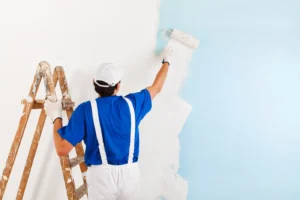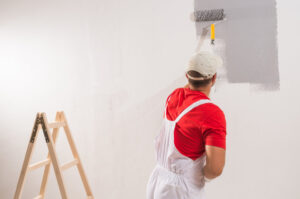Commercial painting might seem like a hassle or an unnecessary expense. However, a fresh paint job is key to renewing your location and attracting new customers.
Painters in West Chester PA have years of experience with different business properties. They know the color schemes that will likely appeal to the customer base and can suggest durable options that will last for a long time.

Aesthetics is the branch of philosophy that deals with the principles and appreciation of beauty. It explores how a work of art appeals to the senses and influences our feelings toward it and how our perception of a piece is shaped by the cultural conventions that dictate its presentation. The field of aesthetics explores a wide variety of subjects, from the definition of art to its relationship with emotion and imitation.
Commercial painting is a powerful tool for elevating business interiors and creating a more welcoming space for clients and customers. But it isn’t just about the look and feel of a space; it’s about creating an experience that reflects the core identity of your brand.
The right color selection can transform a dull and uninspiring workspace into one that stimulates creativity and productivity. A professional commercial painter can help choose colors that align with your company’s goals and values while taking into account their psychological effects on employees. For example, bright shades like blue and green can promote calmness and focus, while rich colors such as red and yellow can inspire inventiveness and vitality.
In addition to choosing the right colors, a commercial painter can also assist in the layout and design of your workspace. A well-thought-out and organized layout is essential for keeping workflow on track, which can have a significant impact on employee morale. A professional commercial painter can help plan your layout and suggest ways to improve efficiency by eliminating clutter or reorganizing furniture.
As more businesses are becoming environmentally conscious, the demand for eco-friendly paints has increased. These paints are low in volatile organic compounds (VOCs) and help promote healthy indoor air quality. In addition, they can showcase a company’s commitment to sustainability and environmental conservation.
In an age where businesses compete for customers and attention, it’s important to stand out from the crowd. A fresh coat of paint is an affordable and effective way to elevate a business’s image and attract customers. A professional commercial painter can help choose the perfect colors and layout to reflect a company’s identity and create a seamless transition from exterior to interior.
Commercial environments have different durability needs than residential spaces. For example, a storefront might need scuff-resistant paint to handle the high amount of foot traffic it sees. A warehouse might need durable coatings to withstand a heavy volume of forklift traffic.
For both interior and exterior commercial painting, the right choice of paint will make all the difference in how long it lasts. A quality commercial painting company will know what type of finish to use in each environment, and they will ensure the surfaces are properly prepped before painting begins. The result will be a longer-lasting and more resistant paint job, and fewer touch ups required over time.
Durability is a major concern for many businesses when they hire a contractor for a commercial painting project. Whether it’s a retail store, manufacturing space, office building or other commercial property, they want to know their investment will last. It’s essential to select a quality paint from the start, such as Sherwin Williams Duration, which is formulated to resist fading, chipping and peeling. This will help the finished product last longer, and it’s a good idea to add a coat of clear polyurethane over the top to further protect the finish.
A reliable commercial painting contractor will work with their clients to schedule the job in a way that minimizes disruption to business operations and productivity. This may include working nights and weekends to avoid interrupting regular business hours. The contractor will also provide an upfront quote and timeline and be receptive to feedback throughout the process.
When hiring a commercial painter, be sure they are bonded and insured to cover any potential damage that could occur during the painting process. A quality contractor will have a strong reputation in the industry and be able to provide references from previous customers. They will also be able to demonstrate their expertise through a portfolio of past projects.
The physical appearance of a building is a critical factor for any business, and commercial painting can make a big difference in customer perception, profitability, and growth. A fresh coat of paint can enhance a company’s image and foster a positive atmosphere for employees to enjoy.
Whether you’re a DIY-er giving your living room a facelift or hiring commercial painting contractors to renovate your warehouse, safety should be a top priority. Most paints contain chemicals that are harmful to the skin and respiratory system. It’s important to wear gloves and a mask when handling these chemicals to protect yourself. It’s also vital to work in a well-ventilated area to reduce your exposure to the fumes. If possible, open windows and use fans to keep the air flowing.
Commercial painting can involve working at heights, which is a serious risk for injuries. Ladders can fall, and people can trip or slip and hurt themselves. In addition, flammable materials like paints and thinners can cause fires. To avoid accidents, reputable commercial painting contractors take care to secure the area before starting the work. They may also put up netting to protect passers-by from falling debris. They also use caution signs and mark off the work zone to prevent anyone from accidentally entering the area.
Most commercial painters are experienced in working at heights, so they know how to properly set up ladders for maximum stability. They use ladders with non-slip feet and locking devices to prevent them from sliding. They also choose ladders that are appropriate for the work being done and have extensions to help them reach higher areas. They also use paints that are flammable-resistant, which helps mitigate the risk of fire.
Working with ladders and other tools can be dangerous, even for experienced painters. A small misstep can lead to a broken bone or a head injury. Injuries can be stressful for many reasons, including loss of income and time off work. Injuries can also affect workplace morale, as employees may feel embarrassed or stressed by their employer’s negligence. Keeping everyone safe during a commercial painting project is the best way to boost morale.
Punctuality is an essential aspect of commercial painting, as it shows respect for others and demonstrates reliability. Keeping your work schedule on track will help you get the job done faster and better. If a delay is unavoidable, be sure to notify all parties involved as soon as possible to avoid any miscommunications.
A professional commercial paint job is a long-term investment that will help your facility stand out and keep employees, customers and tenants happy. A fresh coat of paint can also protect surfaces from damage, and even save money on energy costs in the long run.
Maintaining the look of a painted surface is easy with regular cleaning. Frequent dusting with a damp cloth or microfiber towel will prevent the accumulation of dirt and debris, keeping the paint looking new for longer. Avoid harsh chemicals or abrasive cleaners, as they can damage the paint’s finish. Similarly, avoid putting items on painted walls to reduce the risk of tripping and falling, and regularly check for any signs of moisture or mold.
Commercial painting requires a higher level of diligence than residential projects. This is because it’s often completed in busy areas where a disruption could cost the business money. Punctuality is key for this type of project, as it shows reliability and respect, and helps to build positive working relationships. Commercial painting contractors also need to comply with strict safety regulations set out by government and local bodies.
It’s important to hire a professional for a commercial space because they can offer expert advice and recommendations. They can also prepare the area for painting by removing any unnecessary items and moving desks, cabinets and other furniture to the center of the room. This will make it easier for the painters to work and reduces the risk of injury or accident during the process.
In addition, professional commercial painters have access to a wider range of tools and equipment than the average person, which can speed up the process and deliver better results. They are also used to working around a business’s schedule and using paints that dry quickly, so they can finish the job with minimal disruption.
As a facilities manager, it’s your responsibility to keep your building in good condition for both the health and wellbeing of your staff and the public. A well-maintained exterior and interior can improve your brand image, increase customer satisfaction, and attract the right kind of tenants for your business.



